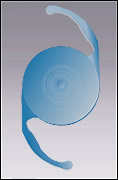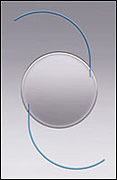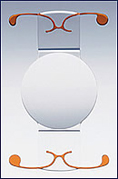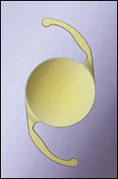Premium Lens Implants
If you are nearing the age for cataract surgery and want a reliable vision correction solution premium intraocular lens implants (IOL) might be a good idea. These lens implants are also referred to as “lifestyle lens implants” because they can provide clear vision without the need for glasses! Before choosing the premium lens implant that is right for you it is important to discuss your your visual needs and expectations with your cataract surgeon.
Several years ago patients only had the option of monofocal lens implants, which enabled vision at one distance only. Today, these advanced technology premium lens implants can provide clear vision at all distances, including near, intermediate and far vision. Premium lens implants have been helping people over 40 and cataract aged patients since they became a viable option. Could you possibly imagine being able to read the newspaper, drive at night or play golf all without the use of glasses? Our doctors are excited to bring these types of options to the patients of Honolulu. They have received additional training and certification in order to use these latest techniques with modern lens implants.
What are the Different Types of Premium Lens Implants?
PanOptix Trifocal IOL
The PanOptix trifocal IOL can be implanted during cataract surgery in Honolulu to improve distance, intermediate, and near vision. It’s the only trifocal lens approved for use in the U.S. by the FDA.
Over 99 percent of patients who participated in a clinical study for the PanOptix trifocal IOL said they would choose the same lens again.
The PanOptix trifocal IOL improves both vision range and quality. Patients with this premium lens notice the difference immediately.
The majority of patients who receive the PanOptix lens do not need to wear glasses to see after cataract surgery. While the PanOptix trifocal IOL has a few potential side effects that may occur, it’s low risk. It can easily be implanted during blade-free cataract surgery in Honolulu.
Multifocal IOL


Multifocal IOLs enable patients to see at near far and intermediate distances after surgery. The 3 major lenses in this category are the the AcrySof ReSTOR IOL by Alcon, the AcrySof ReSTOR ACTIVEFOCUS IOL also by Alcon and the Tecnis Multifocal IOL by Johnson & Johnson. With a multifocal IOL the central portion of the lens has a series of steps that are carved in a very precise arrangement with varying step heights and distances between steps. Each of the steps of this diffractive optic bends the incoming light differently; creating a near focus that is quite separated from the distance focus formed by the remaining refractive portion of the lens. This large separation between the two images allows for less artifacts or distortion in either of the images, providing good quality of vision at both distance and near.
Extended Depth of Focus IOL
Tecnis Symfony IOL is the first presbyopia-correcting extended depth of focus IOL. It delivers a continuous full range of high quality vision with reduced incidence of halos and glare compared to a multifocal IOL. This IOL is implanted into the eye during cataract surgery.
The Symfony lens is approved in more than 50 countries around the world, and has been widely studied, with data from numerous clinical studies involving over 2,000 eyes. In clinical studies, the Symfony lens:
- Provided seamless, day-to-night vision. Patients could see objects sharply and clearly at near, intermediate and far away distances, and points in between.
- Provided high-quality vision. Some IOLs may leave patients with an inability to focus clearly due to competing wavelengths of light passing through the lens at different angles (known as chromatic aberration), or with vision that is not completely focused because of the shape of the lens (known as spherical aberration). The Symfony lens has been engineered to correct these issues.
- Demonstrated a low incidence of halo and glare, which may be perceived as rings or blurring around bright lights. Glare and halo can sometimes affect an individual’s ability to drive at night or to perform other visual tasks.
Accommodating IOL

Accommodating lens implants have garnered a significant amount of positive review and testimonials from thousands of early patient adopters. These special lenses are designed to mimic or accommodate, just like the eyes natural lens would. The hinge design of the lens enables it to move inside the eye just like the original natural lens. The end result is that patients can see better at multiple distances. The accommodating lenses currently available at Sugiki • Portis • Yim Eye Center, these are Crystalens and Trulign both by Bausch & Lomb.
Toric IOL

Toric lens implants are a unique type of lens implant that are used to correct astigmatism. A Toric lens implant is NOT the only method of astigmatism correction; it is important to consult your eye doctor about the best options for your individual needs. Asymmetric steepening of the cornea or natural lens causes light to be focused unevenly, which is the main optical problem in astigmatism. To individuals with uncorrected astigmatism, images may look blurry or shadowed. Astigmatism can accompany any form of refractive error and is very common. Astigmatism can be corrected with glasses, contact lenses, corneal relaxing incisions, laser vision correction, and special implant lenses. If a cataract patient has astigmatism and has aspirations to be glasses free after surgery the Toric lens implant is a good option.
Premium lens implants can be very exciting for patients that want to have a new level of spectacle freedom after cataract surgery or with clear lens extraction. Due to the complex nature of each persons visual system, it is difficult for a patient to make an assessment about the right lens without consulting a medical ophthalmologist. Therefore, we highly suggest a consultation with the one of our ophthalmologists before making any decision on a lens implant.
Apthera IC8 IOL
The Apthera IC-8 IOL is an advanced intraocular lens that corrects blurry vision caused by cataracts accompanied with low-level astigmatism. This artificial lens implantation replaces the eye’s natural lens which has become clouded over time, causing vision to blur. The Apthera IC-8 IOL provides clear vision at all ranges without the necessity of glasses and contact lenses for most patients. Those who have been told they are not candidates for vision correction procedures such as LASIK or PRK may also benefit from the Apthera IC-8 IOL.
5 Benefits of the Apthera™ IOL
- Clear vision across an enhanced range
- Two-in-one cataracts and astigmatism treatment
- Minimally invasive approach, resulting in less eye trauma and a quicker recovery time
- Effective in bright and low light conditions
- Customizable vision correction





